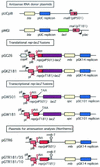An antisense RNA-mediated transcriptional attenuation mechanism functions in Escherichia coli
- PMID: 11976303
- PMCID: PMC135013
- DOI: 10.1128/JB.184.10.2740-2747.2002
An antisense RNA-mediated transcriptional attenuation mechanism functions in Escherichia coli
Abstract
Antisense RNA-mediated transcriptional attenuation is a regulatory mechanism operating in the replication control of two groups of plasmids in gram-positive bacteria, the pT181 group and the inc18 family, represented by pIP501. In contrast, this control mechanism has so far not been identified in gram-negative bacteria or their plasmids. In this work we asked whether such a mechanism can be supported by Escherichia coli. The core replication control regions of plasmids pT181 and pIP501 were transferred into this heterologous host. In vivo lacZ reporter gene assays showed that the antisense RNAs of these plasmids can inhibit lacZ expression and that most of this effect can be accounted for by reduced mRNA readthrough. Northern analyses confirmed that the ratio of attenuated to readthrough target RNA was increased in the presence of the cognate antisense RNA, as expected for this mechanism. Similarly, both antisense RNAs induced premature termination of their cognate target RNAs in an E. coli in vitro transcription system, whereas the noncognate antisense RNAs had no effect. Thus, this report shows that antisense RNA-mediated transcriptional attenuation is supported by at least one gram-negative host, although the data indicate that inhibitory efficiencies are lower than those for, e.g., Bacillus subtilis. Possible explanations for the apparent absence of this control mode in plasmids of gram-negative bacteria are discussed.
Figures



Similar articles
-
Antisense RNA-mediated transcriptional attenuation: an in vitro study of plasmid pT181.Mol Microbiol. 2000 Mar;35(6):1469-82. doi: 10.1046/j.1365-2958.2000.01813.x. Mol Microbiol. 2000. PMID: 10760147
-
Antisense-RNA mediated control of plasmid replication - pIP501 revisited.Plasmid. 2015 Mar;78:4-16. doi: 10.1016/j.plasmid.2014.07.004. Epub 2014 Aug 7. Plasmid. 2015. PMID: 25108234 Review.
-
Antisense RNA-mediated transcriptional attenuation occurs faster than stable antisense/target RNA pairing: an in vitro study of plasmid pIP501.EMBO J. 1994 Aug 1;13(15):3599-607. doi: 10.1002/j.1460-2075.1994.tb06667.x. EMBO J. 1994. PMID: 7520390 Free PMC article.
-
iRAPs curb antisense transcription in E. coli.Nucleic Acids Res. 2019 Nov 18;47(20):10894-10905. doi: 10.1093/nar/gkz791. Nucleic Acids Res. 2019. PMID: 31535128 Free PMC article.
-
Plasmid Replication Control by Antisense RNAs.Microbiol Spectr. 2014 Aug;2(4):PLAS-0001-2013. doi: 10.1128/microbiolspec.PLAS-0001-2013. Microbiol Spectr. 2014. PMID: 26104196 Review.
Cited by
-
A systems view of the protein expression process.Syst Synth Biol. 2011 Dec;5(3-4):139-50. doi: 10.1007/s11693-011-9088-1. Epub 2011 Oct 19. Syst Synth Biol. 2011. PMID: 23205157 Free PMC article.
-
Engineering naturally occurring trans-acting non-coding RNAs to sense molecular signals.Nucleic Acids Res. 2012 Jul;40(12):5775-86. doi: 10.1093/nar/gks168. Epub 2012 Mar 1. Nucleic Acids Res. 2012. PMID: 22383579 Free PMC article.
-
Tuning response curves for synthetic biology.ACS Synth Biol. 2013 Oct 18;2(10):547-67. doi: 10.1021/sb4000564. Epub 2013 Sep 3. ACS Synth Biol. 2013. PMID: 23905721 Free PMC article.
-
Full-length RNA profiling reveals pervasive bidirectional transcription terminators in bacteria.Nat Microbiol. 2019 Nov;4(11):1907-1918. doi: 10.1038/s41564-019-0500-z. Epub 2019 Jul 15. Nat Microbiol. 2019. PMID: 31308523 Free PMC article.
-
Paired termini stabilize antisense RNAs and enhance conditional gene silencing in Escherichia coli.Nucleic Acids Res. 2006;34(20):e138. doi: 10.1093/nar/gkl697. Epub 2006 Oct 24. Nucleic Acids Res. 2006. PMID: 17062631 Free PMC article.
References
-
- Argaman, L., R. Hershberg, J. Vogel, G. Bejerano, E. G. H. Wagner, H. Margalit, and S. Altuvia. 2001. Novel small RNA-encoding genes in the intergenic regions of Escherichia coli. Curr. Biol. 11:941-950. - PubMed
-
- Brantl, S. 1994. The copR gene product of plasmid pIP501 acts as a transcriptional repressor at the essential repR promoter. Mol. Microbiol. 14:473-483. - PubMed
Publication types
MeSH terms
Substances
LinkOut - more resources
Full Text Sources
Other Literature Sources

